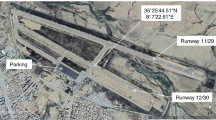Abstract
This paper presents the utilization of models already derived from results of dynamic triaxial tests performed on marginal soils (marl and sabkha) stabilized with foamed and emulsified sulfur asphalt. These stabilized materials are considered to be used as base layers in a pavement structure. Permanent strain relations obtained from dynamic triaxial testing were used in VESYS model to predict rutting performance and magnitude. Predicted rutting performance and magnitude were close to the actual rut depth measured during wheel tracking tests to validate the models. These models developed for rutting prediction were used in VESYS 5 W software to forecast the life or the axle passes needed to attain a rut depth delineating the end of life for a variety of pavement thicknesses, and the subgrade soils to create original pavement thickness design charts. Most of the subgrade soils in Saudi Arabia as well as the coastal areas of the Arabian Gulf are usually marl, sabkha or dune sand soils.















Similar content being viewed by others
References
Abdullah GMS, Al-Abdul Wahhab HI (2015) Evaluation of foamed sulfur asphalt stabilized soils for road applications. Constr Build Mater 88:149–158
Abdullah GMS, Al-Abdul Wahhab HI (2018) Stabilisation of soils with emulsified sulphur asphalt for road applications. Road Mater Pavement Des. https://doi.org/10.1080/14680629.2018.1436465
Aiban S, Al-Abdul Wahhab HI, Al-Amoudi OSB (1999) Identification, evaluation and improvement of eastern Saudi soils for constructional purposes. Final report, KACST Project AR-14-61
Al-Abdul Wahhab HI, Abdullah GMS (2016) Prediction of permanent deformation of foamed and emulsified sulfur asphalt soils mixes. J Eng Res 13(1):01–21
Al-Amoudi OSB, El-Naggar ZR, Siyed IM (1992) The sabkha in the Kingdom of Saudi Arabia and its engineering problems. Al-Muhandis (The Engineer) 6(2):56–62 (in Arabic)
Arnold G (2004) Rutting of granular pavements. Ph.D. thesis, University of Nottingham
Arnold G, Werkemeister S (2010) Pavement thickness design charts derived from a rut depth finite element model. NZ Transport Agency research report no. 427
Baig MG, Al-Abdul Wahhab HI, Isam AM, Al-Mehthel M, Al-Idi SF, Grosch J (2009) Investigation of sulfur modified asphalt concrete mixes for road construction in the gulf. Efficient Transportation and Pavement Systems—Al-Qadi, Sayed, Alnuaimi & Masad (eds)© 2009 Taylor & Francis Group, London, ISBN 978-0-415-48979-9
Benkelman AC (1962) Structural deterioration of test pavements: flexible. The AASHO road test, Highway Research Board Special Report, p 73
Federal Highway Administration (2009) Manual on uniform traffic control devise for streets and highways. HS: 820–168. Federal Highway Administration, Washington, DC
Hicks RG (1982) Use of layer theory in the design and evaluation of pavement systems. Report No. FHWA-AK-RD-83–8
Lekarp F (1997) Permanent deformation behavior of unbound granular materials. Licentiate Thesis, Kungl Tekniska Högskolan, Sweden
Maharaj DK, Gill S (2014a) Development of design chart for flexible pavement by finite element method. Int J Latest Res Eng Comput 2(2):8–23
Maharaj DK, Gill S (2014b) Development of design chart for rigid pavement by finite element method. Int J Latest Res Eng Comput 2(2):27–39
Saudi Geological Survey (2013) https://www.sgs.org.sa/english/geology/phanerozoic/pages/default.aspx
U.S. Army Corps of Engineers (2001) Pavement Design for Airfield. Unified Facilities Criteria (UFC) 3-260-2. Washington, DC: US Army Corps of Engineers
Wardle LJ (1980) Program CIRCLY, a computer program for the analysis of multiple complex loads on layered anisotropic media, users’s manual.
Werkmeister S (2007) Prediction of pavement response using accelerated test results of New Zealand’s CAPTIF facility. TU, Dresden
Author information
Authors and Affiliations
Corresponding author
Additional information
Publisher's Note
Springer Nature remains neutral with regard to jurisdictional claims in published maps and institutional affiliations.
Rights and permissions
About this article
Cite this article
Abdullah, G.M.S. Pavement Thickness Design Charts Derived from Rut Depth Models Developed for Foamed and Emulsified Sulfur Asphalt Soil Mixes. Geotech Geol Eng 38, 3053–3065 (2020). https://doi.org/10.1007/s10706-020-01206-8
Received:
Accepted:
Published:
Issue Date:
DOI: https://doi.org/10.1007/s10706-020-01206-8




